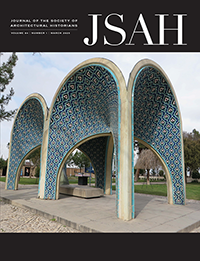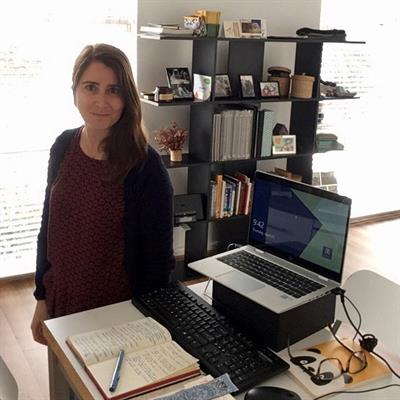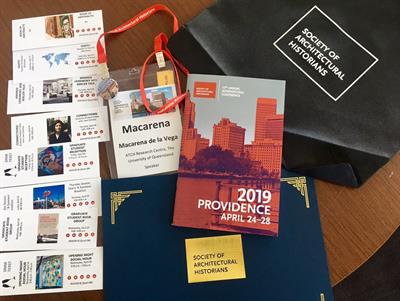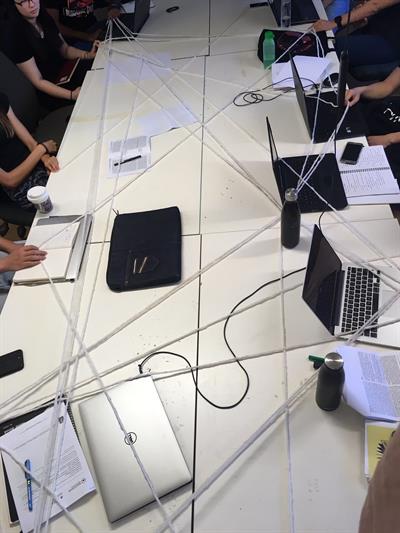-
Membership
Membership
Anyone with an interest in the history of the built environment is welcome to join the Society of Architectural Historians -
Conferences
Conferences
SAH Annual International Conferences bring members together for scholarly exchange and networking -
Publications
Publications
Through print and digital publications, SAH documents the history of the built environment and disseminates scholarshipLatest Issue:

-
Programs
Programs
SAH promotes meaningful engagement with the history of the built environment through its programsMember Programs
-
Jobs & Opportunities
Jobs & Opportunities
SAH provides resources, fellowships, and grants to help further your career and professional life -
Support
Support
We invite you to support the educational mission of SAH by making a gift, becoming a member, or volunteering -
About
About
SAH promotes the study, interpretation, and conservation of the built environment worldwide for the benefit of all
Member Stories: Macarena de la Vega de León
Apr 7, 2021
by
SAH News

Today's profile is Macarena de la Vega de León, an Honorary Research Fellow at The University of Melbourne and SAH member since August of 2018.
First of all, thank you for sharing a little about yourself with the other members. Can you tell us a little about your background and what interests you most about architectural history?
I studied architecture in Madrid, but very quickly realized that it was the history/theory subjects that I liked and was better at. After having done a master's at the same school, it was clear to me that I needed to do my PhD somewhere else. By pure chance, that "somewhere" ended up being Australia.
I am interested in the writing of architecture and its history. Who writes it? What did they have in mind? So far, I have worked on historians from the early and late twentieth century, as well as on more recent histories and histories in Australasia.
Most recently, you have been working from the U.S. As someone who has seen architecture and its history from the perspective of 3 continents, what about architecture is universal, and what about it is particular to its culture and place?
This is a really complicated question to answer briefly. I believe that architecture and its history are not different from people: we combine in ourselves the complexities and contradictions of being human while being a product of our circumstances, the culture and place in which we grow up. Like us, architecture and its history have the potential to be more culturally aware and engaged every single day.
Can you briefly summarize your current work?
I am currently looking for my next job while I continue to publish parts of my dissertation and findings of the research project I undertook last year at the University of Melbourne. I have a ridiculous amount of deadlines this spring for somebody that is currently unemployed, but I am trying to stay in the game so I can be ready and competitive when an opportunity arises. Being in the midst of the storm at the moment, it is hard to see the way through, but all I can do is keep persevering, keep swimming.
Are you looking for opportunities in academia or elsewhere? As work in higher education changes, are there opportunities for emerging professionals outside the university setting?
Again, great questions without an easy answer. Working in academia—one can even say surviving academia—is not easy, and while I am actively searching for opportunities, I am not willing to accept just anything, anywhere, or risk my wellbeing. While careers outside academia are certainly fulfilling for researchers, for the moment I continue to search for an opportunity to teach, to learn, and to research.
How can SAH support young professionals?
SAH’s support since I became a member has been immense, especially during the last year, when the society has risen to address the very trying circumstances and continued to offer opportunities. Very recently, I have benefitted from my participation in the Method Acts workshops and the SAH/GAHTC Teacher-to-Teacher workshop.
Do you have a particular memory of when you first became aware of the significance of architecture or when you knew you wanted to study it?
I can’t really name one particular moment or reason. My parents are very fond of travelling, and I travelled with them and also on my own, visiting family since I was very young. With visiting new places, there is always the fixation on sightseeing. Before starting university, I had visited Paris, New York, Boston….
Do you have a particular building or landscape in Paris, New York, or Boston that stands out in your mind?Interestingly, more than a particular building or park, what I always remember best—and keep in mind, I have a terrible memory—is the feeling of walking on these (and other) cities’ streets.
Do you have a particular architect or architectural historian that has influenced your work and career?
First and foremost, I would have to name my PhD supervisor, the reason I went to Australia, Gevork Hartoonian. In Australia, I have also found supportive mentors in my bosses John Marcarthur, Paul Walker, and Hannah Lewi. I have met people that have showed genuine interest in my work and have helped generously along the way like Julia Gatley, Mirjana Lozanovska, and Ana Esteban Maluenda. Of course, I have people whose work I admire, and SAH has given me great chances to interact with them. This would be people like Sibel Bozdoğan, Kathleen James-Chakraborty, Mark Jarzombek, and very recently, even if virtually, Esra Ackan.
If a layperson asked why we should study architecture and its history, what would you say?
I do believe that it helps in understanding the past. How humans have lived and interacted can be understood through studying cities and buildings.
When and how did you become involved with SAH?
 In 2018, I was selected to participate in the 2019 annual conference in Providence. I joined as a student who had just submitted the dissertation, which was still under revision, and I presented at Providence having just graduated.
In 2018, I was selected to participate in the 2019 annual conference in Providence. I joined as a student who had just submitted the dissertation, which was still under revision, and I presented at Providence having just graduated.
I travelled from Australia supported by one of SAH's fellowships, I presented as part of a great session chaired by David Rifkind and Elie Haddad, whose work I had followed, and with whom I have continued to collaborate. That is one of the deadlines that I have coming up.
How else has SAH enriched your work and experience with architectural history?
Last year, I was chair of a session, so I was part of the first virtual conference. My co-chair, Brett Tippey, and I continued to work with our participants in the development of their papers for publication as co-editors of an issue of Fabrications: The Journal of the Society of Architectural Historians, Australia and New Zealand that should be out very soon.
The less obvious: being welcomed by none other than Victoria Young, who I had “met” on Twitter, into an amazing family, and it feels indeed as one. The communication with SAH officers at different stages has always been great and familiar. I even had the chance to learn from Helena (SAH Director of Communications) when I was trying to set up the communications for SAHANZ, the partner society in Australia and New Zealand.I also got to meet really interesting people coming from or working on Latin America, who welcomed me like another Latin-Americanist.
The opportunities that came from attending the conference are immense: the program for graduate students, the professional headshot, and the GAHTC teacher-to-teacher
 workshop that I attended, organized by Ana María León, where I got to learn from Daniela Sandler, among other educators and scholars. Tricks came up in the discussions that I put into practice as soon as I landed in my own teaching. For example, in the image you can see the result of the tutorial’s discussion with the students. I would start with a prompt/question and throw the ball of yarn to whoever would like to answer or continue with the discussion. Given how visual we are, very quickly students would be aware if they had contributed too much and encourage others to participate.
workshop that I attended, organized by Ana María León, where I got to learn from Daniela Sandler, among other educators and scholars. Tricks came up in the discussions that I put into practice as soon as I landed in my own teaching. For example, in the image you can see the result of the tutorial’s discussion with the students. I would start with a prompt/question and throw the ball of yarn to whoever would like to answer or continue with the discussion. Given how visual we are, very quickly students would be aware if they had contributed too much and encourage others to participate.The Method Acts workshops were new to SAH this year. How do you think they lived up to expectations and how could they be even better?
The February workshop demonstrated that emerging scholars are eager to share their work beyond their institutions and more than once a year, if there is luck, as did the workshops for the students selected to participate in the lighting talks. I believe there is potential for a monthly or bi-monthly workshop of the sort.
The last year has seen significant changes in our communities and in SAH itself. Do you have a vision for how SAH should evolve in the future, and how do you see yourself as part of that growth?
I think that SAH demonstrated last year that it grows with adversity: it delivered a conference and developed an online program of depth and breadth that has no rival worldwide. But most importantly, it has stepped up in terms of its advocacy against inequities and social injustice, and its responses to presidential interferences with the appearance of the built environment. It has shown efficacy and speed in those responses.
Last question: what advice would you give to a young person considering a career in architectural history or a related field?
The only advice that I can give, that should be taken with a pinch of salt, as I do not think I have a career in architectural history yet, is to just keep swimming. If you are as lucky as I am, try to find ways to do what you are passionate about, and opportunities will come your way. You just need to keep an open mind.
SAH members engage with the history of the built environment through a broad array of specializations, professional fields, and areas of interest. Member Stories is a regular feature that recognizes the expertise and unique experiences of our members.

